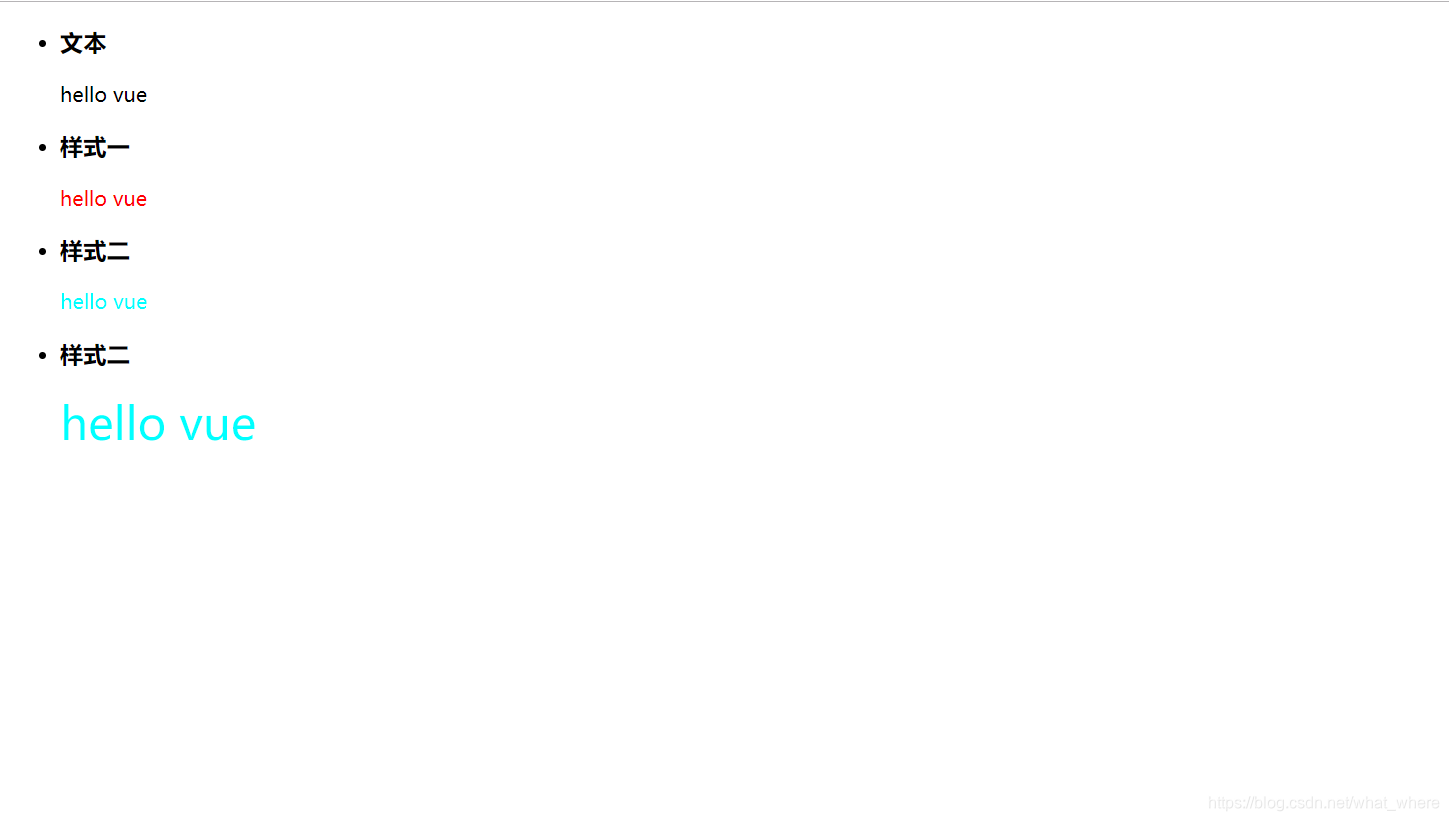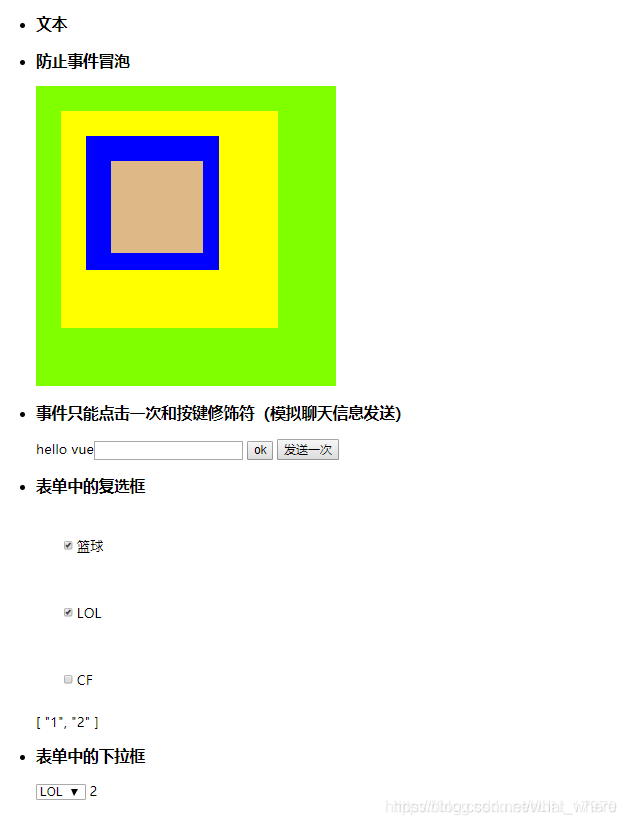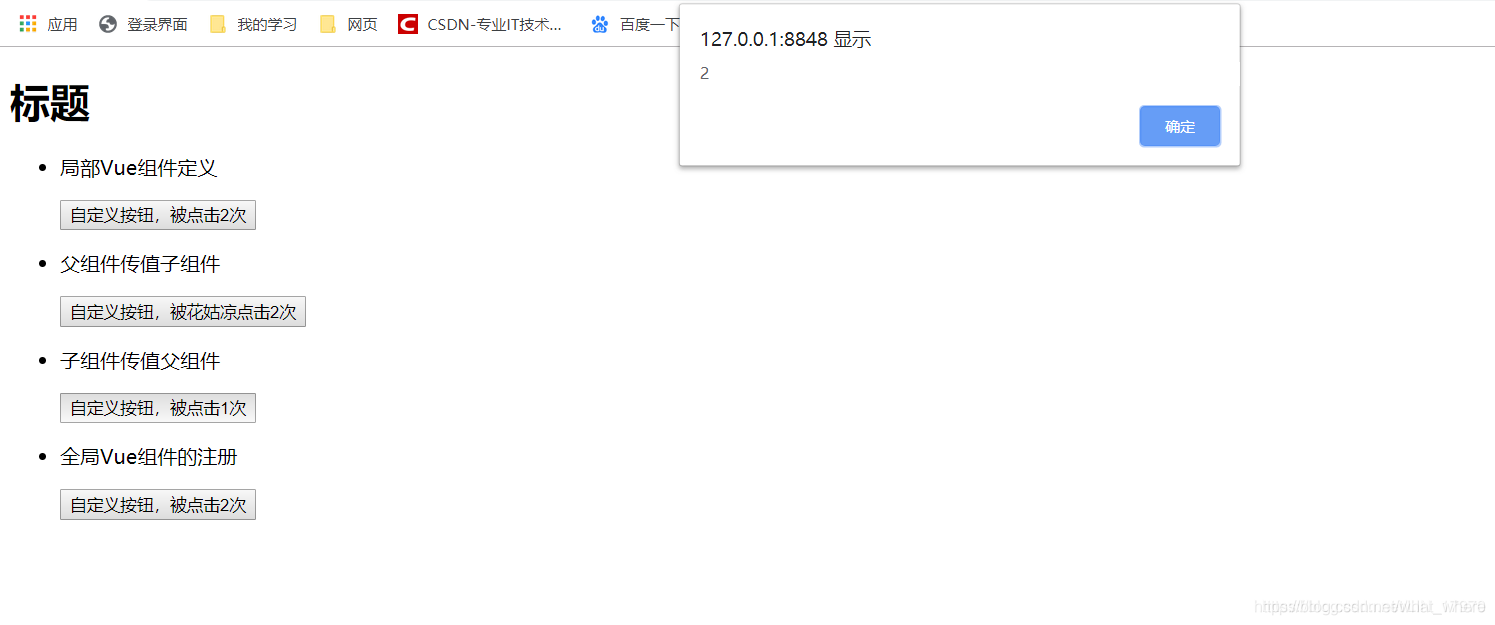样式绑定
1.1 class绑定
使用方式:v-bind:class=“expression”
expression的类型:字符串、数组、对象
1.2 style绑定
v-bind:style=“expression”
expression的类型:字符串、数组、对象
关键代码:
<!DOCTYPE html>
<html>
<head>
<meta charset="utf-8">
<script src="https://cdn.bootcss.com/vue/2.6.10/vue.js"></script>
<title>vue的样式绑定</title>
<style>
.a{
color: red;
}
.b{
color: aqua;
}
.c{
font-size: 36px;
}
</style>
</head>
<body>
<div id="app">
<ul>
<li>
<h3>文本</h3>
{{msg}}
</li>
<li>
<h3>样式一</h3>
<div :class="xa">{{msg}}</div>
</li>
<li>
<h3>样式二</h3>
<div :class="xb">{{msg}}</div>
</li>
<li>
<h3>样式二</h3>
<div :class="xc">{{msg}}</div>
</li>
</ul>
</div>
</body>
<script type="text/javascript">
new Vue({
el: "#app",
data() {
return {
msg: "hello vue",
xa:'a',
xb:'b',
xc:['b','c']
}
}
})
</script>
</html>
效果展示:

事件处理
2.1阻止单击事件冒泡
<a v-on:click.stop="doThis"></a>
<!-- click 事件只能点击一次 -->
<a v-on:click.once="doThis"></a>
Vue允许为v-on在监听键盘事件时添加按键修饰符:
<!-- 只有在 keyCode 是 13 时调用 vm.submit() -->
<input v-on:keyup.13="submit">
Vue为最常用的按键提供了别名
<!-- 同上 -->
<input v-on:keyup.enter="submit">
代码展示:
<!DOCTYPE html>
<html>
<head>
<meta charset="utf-8">
<script src="https://cdn.bootcss.com/vue/2.6.10/vue.js"></script>
<title>Vue的事件处理器</title>
<style>
div{
padding: 30px;
}
</style>
</head>
<body>
<div id="app">
<ul>
<li>
<h3>文本</h3>
{{msg}}
</li>
<li>
<h3>防止事件冒泡</h3>
<div style="height: 300px; width: 300px; background-color:chartreuse;" @click="a">
<div style="height: 200px; width: 200px; background-color:yellow;" @click="b">
<div style="height: 100px; width: 100px; background-color: blue;" @click="c">
<div style="height: 50px; width: 50px; background-color:burlywood;" @click="d">
</div>
</div>
</div>
</div>
</li>
<li>
<h3>事件只能点击一次和按键修饰符(模拟聊天信息发送)</h3>
{{qq}}<input type="text" v-on:keyup.enter="send" v-model="msg" />
<button @click="send">ok</button>
<button @click.once="send">发送一次</button>
</li>
<li>
<h3>表单中的复选框</h3>
<div v-for="item ,index in hobby">
<input type="checkbox" v-model="checkedID" name="hobby" :value="item.id" />{{item.name}}
</div>
{{checkedID}}
<li>
<h3>表单中的下拉框</h3>
<select name="likes" v-model="selectID">
<option v-for="item ,index in hobby" :value="item.id">{{item.name}}</option>
</select>
{{selectID}}
</li>
</ul>
</div>
</body>
<script type="text/javascript">
new Vue({
el: "#app",
data() {
return {
msg: 'hello vue',
qq: null,
hobby:[{
id: '1',
name: '篮球'
},
{
id: '2',
name: 'LOL'
},
{
id: '3',
name: 'CF'
}
],
checkedID:[],
selectID:[]
};
},
methods: {
a() {
alert('a');
},
b() {
alert('b');
},
c() {
alert('c');
},
d() {
alert('d');
},
send() {
this.qq = this.msg;
this.msg = null;
}
}
});
</script>
</html>
效果展示:

表单
用v-model指令在表单控件元素上创建双向数据绑定
代码展示:
<!DOCTYPE html>
<html>
<head>
<meta charset="utf-8">
<script src="https://cdn.bootcss.com/vue/2.6.10/vue.js"></script>
<title>表单</title>
</head>
<body>
<div id="app">
<h1>标题</h1>
<ul>
<li>
<p>vue表单</p>
<label>姓名:</label><input v-model="uname" /><br />
<label>密码:</label><input v-model="upwd" type="password" /><br />
<!-- 将用户的输入值转为 Number 类型 -->
<label>年龄:</label><input v-model.number="age" /><br />
<label>性别:</label>
<input type="radio" v-model="sex" name="sex" value="1" />男
<input type="radio" v-model="sex" name="sex" value="0" />女<br />
<label>爱好:</label>
<div v-for="h in hobby">
<input type="checkbox" v-model="hobbies" v-bind:value="h.id" />{{h.name}}
</div>
<label>类别:</label>
<select v-model="type">
<option value="-1">===请选择===</option>
<option v-for="t in types" v-bind:value="t.id">{{t.name}}</option>
</select><br />
<label>备注:</label>
<textarea v-bind:value="mark"></textarea><br />
确认<input type="checkbox" v-model="flag" />
<input type="submit" v-bind:disabled="show" v-on:click="doSubmit" />
</li>
</ul>
</div>
</body>
<script type="text/javascript">
new Vue({
el: '#app',
data() {
return {
uname: null,
upwd: null,
age: 10,
sex: 1,
hobby: [{
id: 1,
name: '篮球'
}, {
id: 2,
name: '足球'
}, {
id: 3,
name: '象棋'
}],
hobbies: [],
types: [{
id: 1,
name: 'A'
}, {
id: 2,
name: 'B'
}, {
id: 3,
name: 'C'
}],
type: null,
mark: '学生备注',
flag: false
}
},
computed: {
show: function() {
return !this.flag;
}
},
methods: {
doSubmit: function() {
console.log('doSubmit')
var obj = {
uname: this.uname,
upwd: this.upwd,
age:this.age+10,
sex: this.sex,
hobbies:this.hobbies,
type: this.type,
mark: this.mark,
}
console.log(obj);
}
}
})
</script>
</html>
效果:

组件
4.1局部组件
局部组件:
new Vue({el:’#d1’,components:{…}})
4.2父组件传值子组件
props是父组件用来传递数据的一个自定义属性。
父组件的数据需要通过props把数据传给子组件,子组件需要显式地用props选项声明 “prop”
4.3子组件传值父组件
vue中父组件通过prop传递数据给子组件,而想要将子组件的数据传递给父组件,则可以通过自定义事件的绑定
父Vue实例->Vue实例,通过prop传递数据
子Vue实例->父Vue实例,通过事件传递数据
4.4全局Vue组件的注册
全局组件:Vue.component(tagName, options),tagName为组件名,options为配置选项。
代码展示:
<!DOCTYPE html>
<html>
<head>
<meta charset="utf-8">
<script src="https://cdn.bootcss.com/vue/2.6.10/vue.js"></script>
<title>组件</title>
</head>
<body>
<div id="app">
<h1>标题</h1>
<ul>
<li>
<p>局部Vue组件定义</p>
<my-button ></my-button>
</li>
<li>
<p>父组件传值子组件</p>
<my-button m="花姑凉"></my-button>
</li>
<li>
<p>子组件传值父组件</p>
<my-button @three-click="dosss"></my-button>
</li>
<li>
<p>全局Vue组件的注册</p>
<my-button2 ></my-button>
</li>
{{xs}}
</ul>
</div>
</body>
<script type="text/javascript">
Vue.component('my-button2',{
props:['m'],
template:'<button @click="doxxx" >自定义按钮,被{{m}}点击{{n}}次</button>',
data(){
return{
n:0
}
},
methods:{
doxxx(){
this.n++;
this.$emit('three-click',this.n,'Vue','描述');
},
}
}
)
new Vue({
el: '#app',
data() {
return {
msg :'hello vue 组件'
}
},
computed:{
xs(){
return this.n;
}
},
methods:{
dosss(n,x,y){
alert(n);
alert(x);
alert(y);
}
}
,
components:{
'my-button':{
props:['m'],
template:'<button @click="doxxx" >自定义按钮,被{{m}}点击{{n}}次</button>',
data(){
return{
n:0
}
},
methods:{
doxxx(){
this.n++;
this.$emit('three-click',this.n,'Vue','描述');
},
}
}
}
})
</script>
</html>
效果:









 本文介绍了Vue的基础语法,包括样式绑定的class与style使用,事件处理中的阻止冒泡和按键修饰符,以及表单的v-model双向数据绑定。深入探讨了组件的使用,如局部组件的创建、父组件通过props向子组件传值、子组件通过自定义事件向父组件传值,并简要提到了全局Vue组件的注册。
本文介绍了Vue的基础语法,包括样式绑定的class与style使用,事件处理中的阻止冒泡和按键修饰符,以及表单的v-model双向数据绑定。深入探讨了组件的使用,如局部组件的创建、父组件通过props向子组件传值、子组件通过自定义事件向父组件传值,并简要提到了全局Vue组件的注册。
















 1151
1151

 被折叠的 条评论
为什么被折叠?
被折叠的 条评论
为什么被折叠?








